National Trauma Transformation Programme: workforce survey 2024
This report presents the main findings from a survey carried out with the workforce in Scotland exploring awareness and attitudes to psychological trauma and trauma-informed practice. The survey was carried out by the Improvement Service as part of the National Trauma Transformation Programme.
3. Self-assessed Confidence and Understanding
Overall Confidence and Understanding
Respondents were asked to assess their own understanding and confidence against a range of statements related to the concept and impact of trauma and of trauma-informed practice. The four statements are shown in the box below.
Self-Assessed Confidence Statements
1. Understanding of the concept of psychological trauma
2. Understanding of the impact of psychological trauma
3. Understanding of the principles of trauma-informed practice
4. Confidence in applying the principles of trauma-informed practice in your work
Respondents reported relatively high levels of confidence across all four of these statements, with a greater proportion saying they were “extremely confident” or “very confident” than “not at all confident” or “not so confident” for all.
Confidence was highest in relation to understanding of the impact of psychological trauma with 54 percent stating they were very confident or extremely confident. This was an increase from 46 percent in 2021. Only 10 percent of respondents stated they were not so confident or not at all confident for this statement.[4]
Respondents were less confident in applying the principles of trauma-informed practice. This statement had the lowest rating of confidence across the four statements with 39 percent stating they were confident or extremely confident and 26 percent stating they were not so confident or not at all confident.
Respondent comments: “It would be fantastic to see trauma informed practice embedded throughout Scotland, perhaps ambitious, but I believe necessary.”

Compared to 2021, there were increased levels of confidence across all four of these self-assessed confidence statements. The proportion of positive responses, that is those describing themselves as “very confidence” or “extremely confident”, across each statement showed a statistically significant increase since the previous survey.
The largest increase in positive responses was for the statement “understanding of the principles of trauma-informed practice”. The proportion of respondents who were very confident or extremely confident about this statement increased by 13 percentage points from 31 percent of respondents in 2021 to 44 percent in 2024.
Although respondents were least confident in applying the principles of trauma-informed practice in their work, the proportion of respondents saying they were very or extremely confident in response to this statement increased by 12 percentage points between the two surveys. A full comparison of responses by statement is shown in Figure 6.
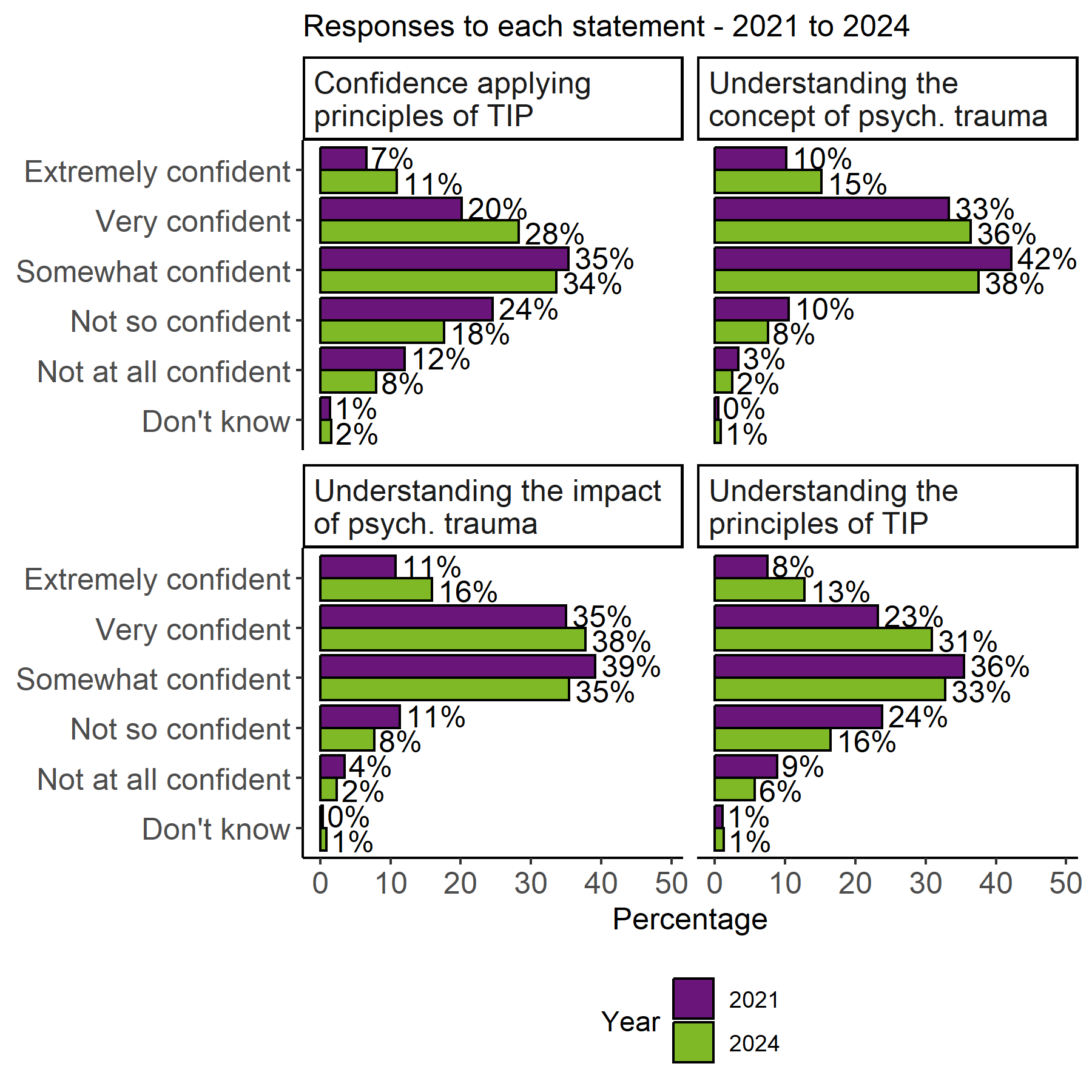
Confidence and understanding by sector, service area and job role.
Analysis of the levels of confidence across sector, service area and job role highlight some differences.
Sector
As was the case with the previous iteration of the survey, self-assessed confidence and understanding was strongest amongst those working in the third/voluntary sector. Respondents from the public sector account for the largest proportion of overall respondents, however this sector generally had lower ratings of confidence across the statements when compared with the third/voluntary sector.
Despite this, the proportion of public sector respondents who responded as very confident or extremely confident for all four statements has significantly increased since the last iteration of the survey. A full breakdown of “confident” responses by service area and by statement is shown in Table 1.
| Question | Sector | 2021 | 2024 |
|---|---|---|---|
| Confidence in applying the principles of trauma-informed practice in your work | Third/voluntary | 36% | 57% |
| Public | 24% | 38% | |
| Private/independent | 32% | 37% | |
| Other | 21% | 22% | |
| Understanding of the concept of psychological trauma | Third/voluntary | 53% | 66% |
| Public | 41% | 51% | |
| Private/independent | 44% | 50% | |
| Other | 34% | 31% | |
| Understanding of the impact of psychological trauma | Third/voluntary | 56% | 67% |
| Private/independent | 44% | 55% | |
| Public | 43% | 53% | |
| Other | 49% | 37% | |
| Understanding of the principles of trauma-informed practice | Third/voluntary | 42% | 60% |
| Private/independent | 31% | 44% | |
| Public | 29% | 42% | |
| Other | 22% | 22% |
The largest improvement amongst public sector responses was for the statement “Understanding of the principles of trauma-informed practice”. In the most recent survey 42 percent of public sector respondents stated they were very confident or extremely confident in relation to this statement compared with 29 percent in 2021. Figure 7 shows the breakdown of responses to this statement by service area for 2021 and 2024.
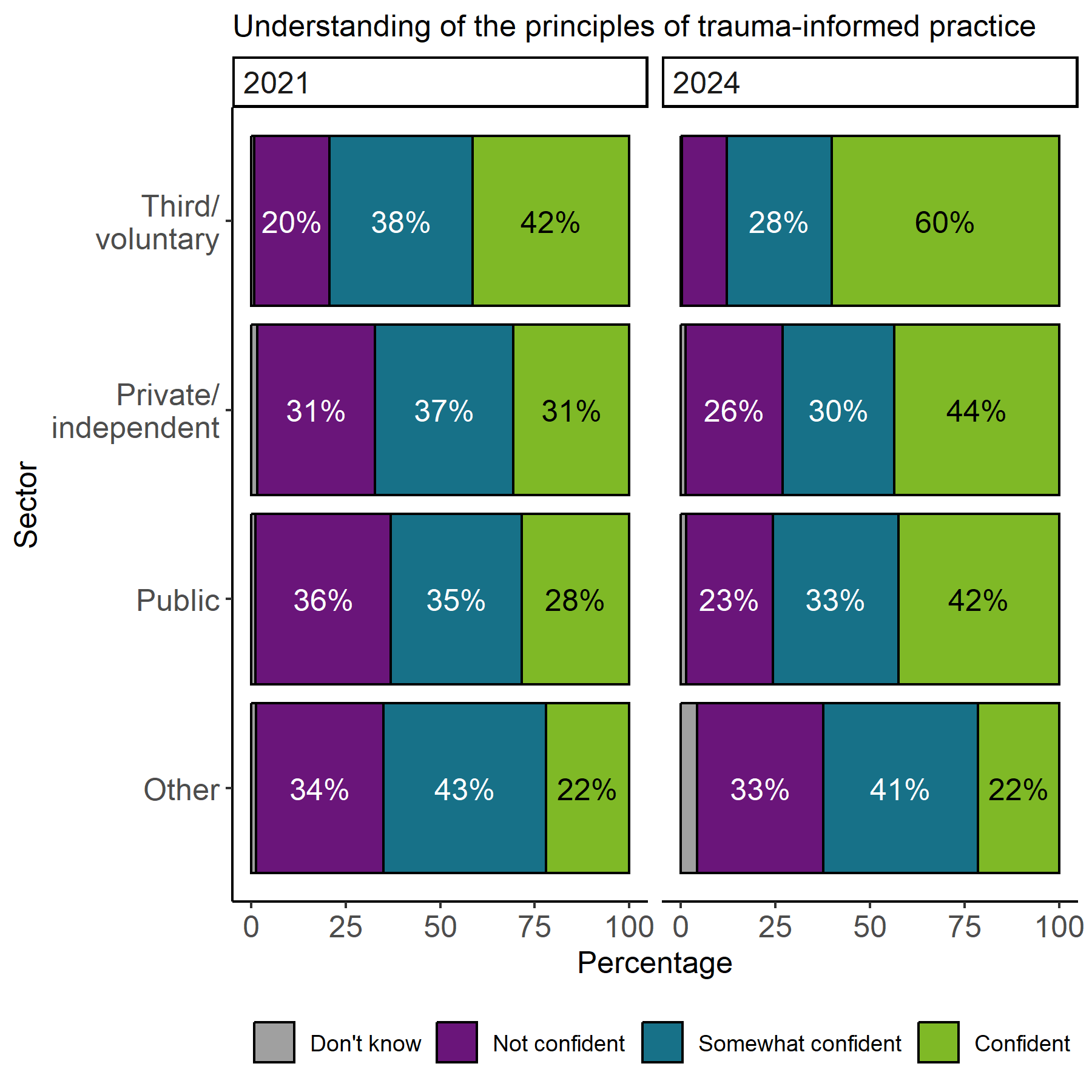
Service Area
Self-assessed confidence and understanding were rated highest by respondents from service areas most likely to be working in this area day to day. Across the four statements, confidence was highest amongst those working in violence against women and equalities, alcohol and drugs, and mental health. Respondents working in violence against women and equalities showed the most confidence and understanding overall, with positive responses at around 70 percent for all four statements. The full breakdown by service area is shown in the following tables.
| Question | Service Area | 2021 | 2024 |
|---|---|---|---|
| Understanding of the impact of psychological trauma | Alcohol and drugs | 57% | 70% |
| Children & families | 52% | 64% | |
| Communications | NA | 54% | |
| Community safety | 43% | 63% | |
| Digital/Data | 38% | 42% | |
| Don’t know | 40% | 41% | |
| Early years and childcare | 40% | 54% | |
| Economic development | 34% | 33% | |
| Emergency Services | 38% | 51% | |
| Employability | 30% | 49% | |
| Finance & administration | 13% | 32% | |
| Further or Higher Education | 68% | 49% | |
| Housing and homelessness | 48% | 54% | |
| Human Resources | 11% | 47% | |
| Justice | 47% | 64% | |
| Learning, development & training | 43% | 55% | |
| Mental health | 61% | 72% | |
| Physical health | 37% | 57% | |
| Planning/Building Standards | 18% | 26% | |
| Primary or Secondary Education | 46% | 53% | |
| Social care and social work | 46% | 48% | |
| Transport/Roads | 18% | 42% | |
| Violence against women & equalities | 61% | 78% |
| Question | Service Area | 2021 | 2024 |
|---|---|---|---|
| Understanding of the concept of psychological trauma | Alcohol and drugs | 53% | 69% |
| Children & families | 50% | 63% | |
| Communications | NA | 57% | |
| Community safety | 38% | 60% | |
| Digital/Data | 38% | 40% | |
| Don’t know | 33% | 35% | |
| Early years and childcare | 38% | 52% | |
| Economic development | 31% | 29% | |
| Emergency Services | 43% | 50% | |
| Employability | 3% | 49% | |
| Finance & administration | 16% | 30% | |
| Further or Higher Education | 58% | 51% | |
| Housing and homelessness | 45% | 50% | |
| Human Resources | 11% | 50% | |
| Justice | 46% | 63% | |
| Learning, development & training | 39% | 54% | |
| Mental health | 59% | 70% | |
| Physical health | 34% | 55% | |
| Planning/Building Standards | 36% | 21% | |
| Primary or Secondary Education | 43% | 50% | |
| Social care and social work | 42 % | 44% | |
| Transport/Roads | 9% | 42% | |
| Violence against women & equalities | 54% | 75% |
| Question | Service Area | 2021 | 2024 |
|---|---|---|---|
| Understanding of the principles of trauma-informed practice | Alcohol and drugs | 45% | 62% |
| Children & families | 39% | 55% | |
| Communications | NA | 42% | |
| Community safety | 27% | 54% | |
| Digital/Data | NA | 26% | |
| Don’t know | 20% | 24% | |
| Early years and childcare | 28% | 45% | |
| Economic development | 11% | 22% | |
| Emergency Services | 24% | 36% | |
| Employability | 40% | 42% | |
| Finance & administration | 5% | 20% | |
| Further or Higher Education | 35% | 42% | |
| Housing and homelessness | 35% | 47% | |
| Human Resources | NA | 40% | |
| Justice | 32% | 55% | |
| Learning, development & training | 30% | 47% | |
| Mental health | 44% | 60% | |
| Physical health | 21% | 42% | |
| Planning/Building Standards | 9% | 14% | |
| Primary or Secondary Education | 29% | 44% | |
| Social care and social work | 29% | 39% | |
| Transport/Roads | 5% | 29% | |
| Violence against women & equalities | 43% | 74% |
| Question | Service Area | 2021 | 2024 |
|---|---|---|---|
| Confidence in applying the principles of trauma-informed practice in your work | Alcohol and drugs | 42% | 58% |
| Children & families | 33% | 51% | |
| Communications | NA | 40% | |
| Community safety | 29% | 48% | |
| Digital/Data | NA | 23% | |
| Don’t know | 13% | 24% | |
| Early years and childcare | 24% | 43% | |
| Economic development | 13% | 18% | |
| Emergency Services | 24% | 35% | |
| Employability | 30% | 38% | |
| Finance & administration | 7% | 15% | |
| Further or Higher Education | 35% | 38% | |
| Housing and homelessness | 32% | 44% | |
| Human Resources | NA | 31% | |
| Justice | 31% | 48% | |
| Learning, development & training | 28% | 39% | |
| Mental health | 39% | 55% | |
| Physical health | 18% | 34% | |
| Primary or Secondary Education | 25% | 38% | |
| Social care and social work | 24% | 35% | |
| Transport/Roads | 9% | 20% | |
| Violence against women & equalities | 42% | 68% |
Most service areas showed an increase in confidence from the previous survey. Some increases include:
- A statistically significant increase in the proportion of respondents working in Physical Health who stated they were very confident or extremely confident in their understanding of the concept of psychological trauma. This increased by 21 percentage points from 34 percent in 2021 to 55 percent in 2024.
- Respondents working in Physical Health also showed a significant increase in understanding of the impact of psychological trauma. The proportion who were very confident or extremely confident increased 20 percentage points from 37 percent in 2021 to 57 percent in 2024.
- “Very” or “extremely” confident responses to the statement, “Understanding of the principles of trauma-informed practice”, significantly increased for respondents working in Community Safety. In 2021 27 percent stated they were very confident or extremely confident, increasing to 54 percent in 2024.
- In 2021, 24 percent of respondents working in Early Years and Childcare stated they were very confident or extremely confident in applying the principles of trauma-informed practice in their work. This proportion increased to 43 percent in 2024, a statistically significant increase of 20 percentage points.
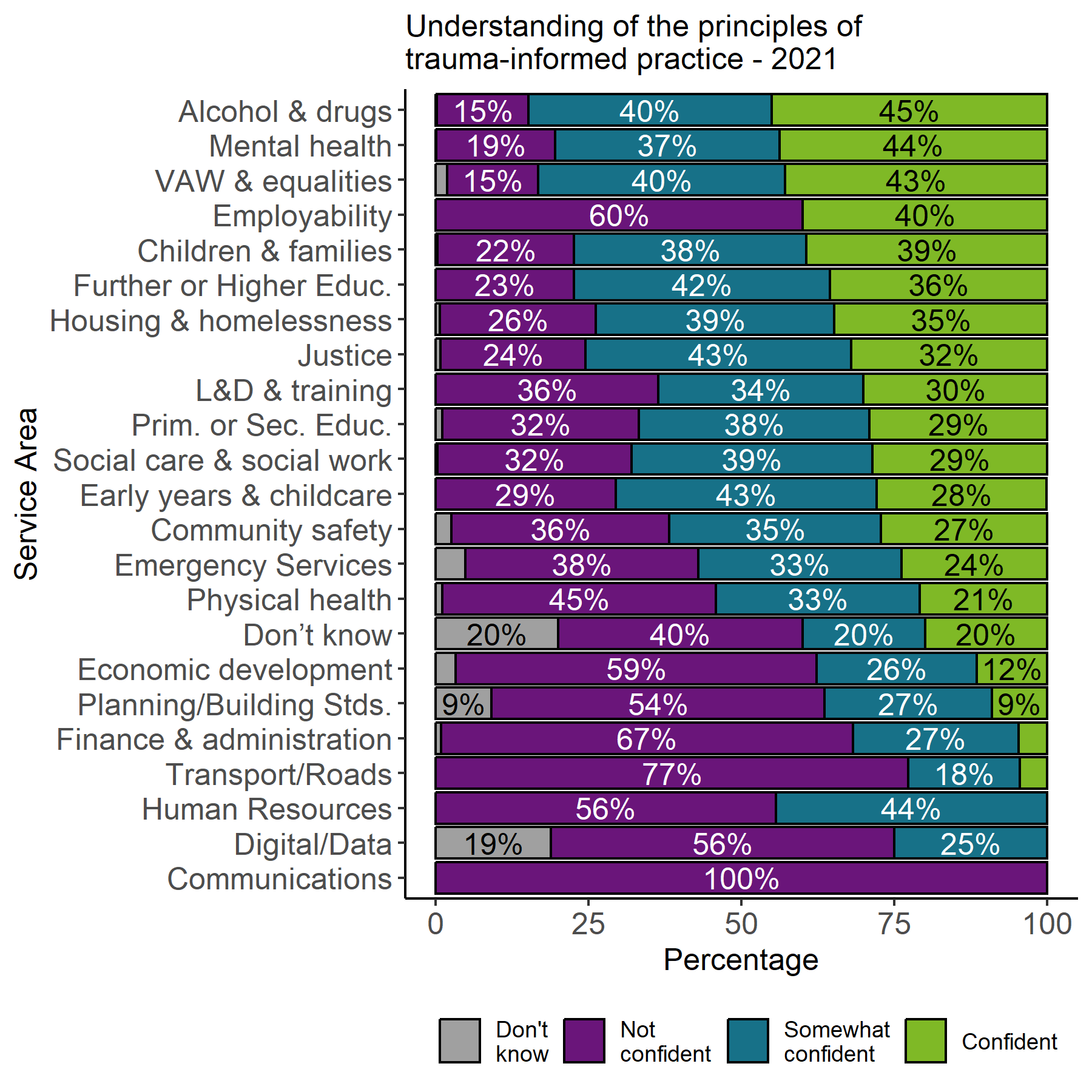
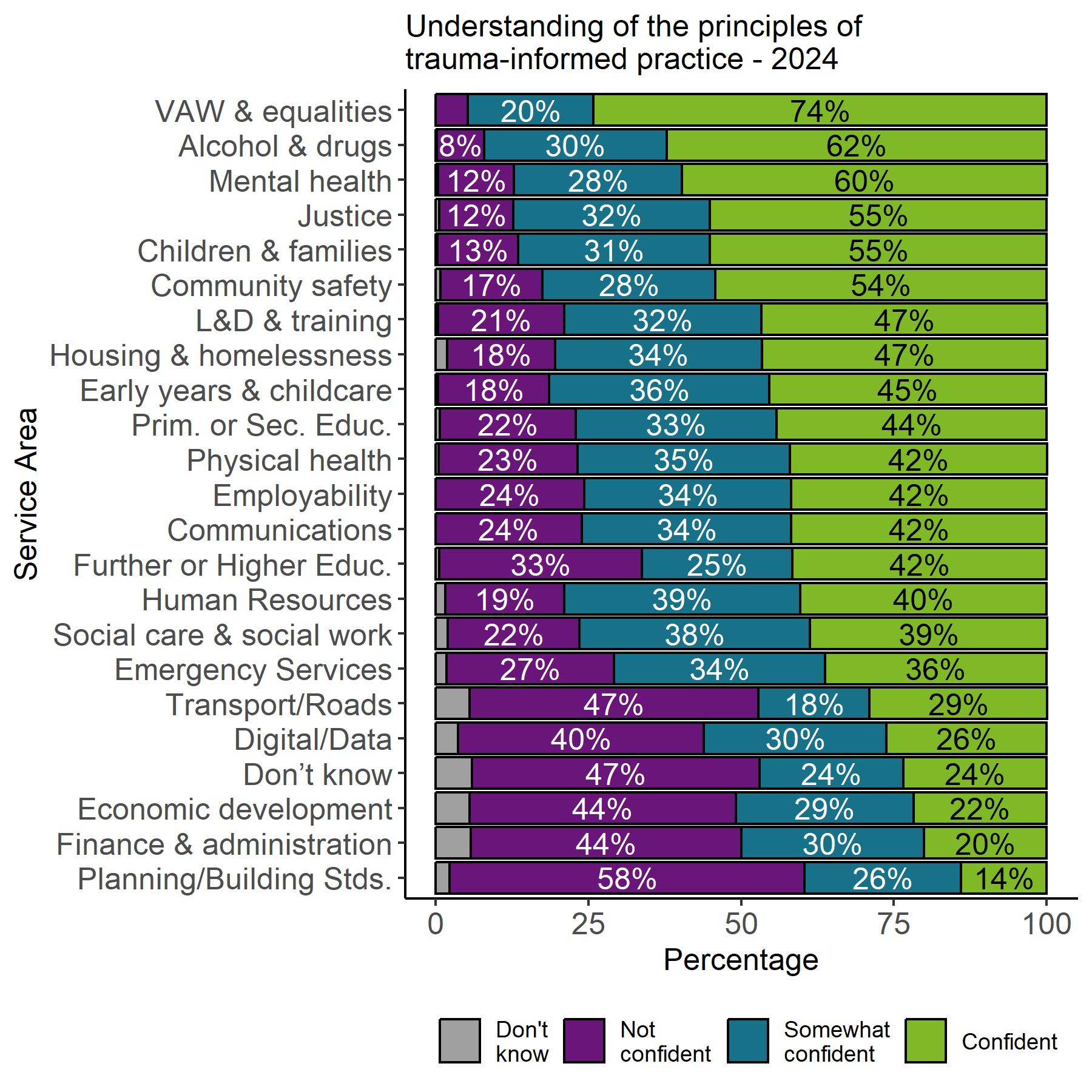
Job Role
Although respondents in senior management roles represented a relatively small proportion, 2.3 percent, of survey responses, this group had the highest ratings of self-assessed confidence and understanding across all four statements. The proportion of confident responses from senior management was statistically significantly higher than the average for the full survey sample with over 60 percent of senior management respondents describing themselves as confident across all four statements.
The statements related to understanding of the concept and impact of psychological trauma both had very high levels of confidence amongst senior management respondents. Both statements had over 70 percent of senior management respondents who were very confident or extremely confident and less than 5 percent who were not so confident or not at all confident. A full breakdown by job role in response to these statements is shown in Figure 10 and Figure 11.
Respondent comments: “I don’t think there’s institutional resistance to it… It is considered in the ‘most obvious’ service areas - social work, education, etc - but should be running through all aspects of the service delivery of the council… anywhere that council officers come into direct contact with people.”

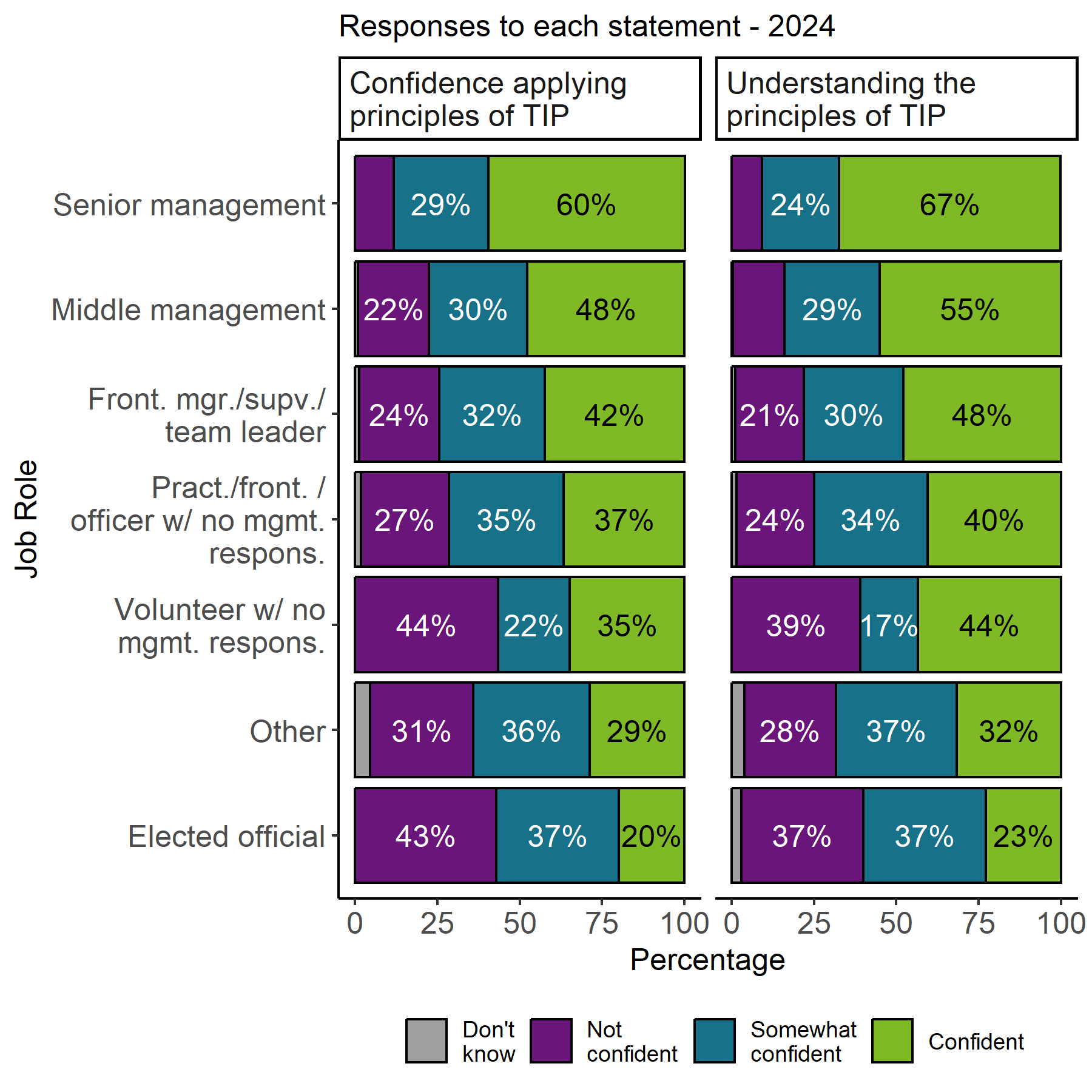
Improvements from the previous survey were seen for almost all job roles across all statements, with the largest increases for those in senior management and middle management roles. These results are shown in Table 6 and Table 7.
| Question | Job Role | 2021 | 2024 |
|---|---|---|---|
| Understanding of the impact of psychological trauma | Senior management | 53% | 77% |
| Middle management | 45% | 59% | |
| Frontline manager/supervisor/team leader | 45% | 57% | |
| Practitioner/frontline service delivery/officer with no management responsibilities | 45% | 52% | |
| Volunteer with no management responsibilities | 39% | 48% | |
| Other | 48% | 42% | |
| Elected official | 40% | 34% | |
| Understanding of the concept of psychological trauma | Senior management | 52% | 74% |
| Middle management | 42% | 62% | |
| Frontline manager/supervisor/team leader | 42% | 54% | |
| Volunteer with no management responsibilities | 39% | 52% | |
| Practitioner/frontline service delivery/officer with no management responsibilities | 42% | 49% | |
| Other | 47% | 40% | |
| Elected official | 40% | 31% |
| Question | Job Role | 2021 | 2024 |
|---|---|---|---|
| Understanding of the principles of trauma-informed practice | Senior management | 37% | 67% |
| Middle management | 33% | 55% | |
| Frontline manager/supervisor/team leader | 30% | 48% | |
| Volunteer with no management responsibilities | 26% | 43% | |
| Practitioner/frontline service delivery/officer with no management responsibilities | 29% | 40% | |
| Other | 33% | 32% | |
| Elected official | 20% | 23% | |
| Confidence in applying the principles of trauma-informed practice in your work | Senior management | 33% | 60% |
| Middle management | 28% | 48% | |
| Frontline manager/supervisor/team leader | 27% | 42% | |
| Practitioner/frontline service delivery/officer with no management responsibilities | 25% | 37% | |
| Volunteer with no management responsibilities | 22% | 35% | |
| Other | 30% | 29% | |
| Elected official | 20% | 20% |
Contact
Email: ACEstrauma@gov.scot
There is a problem
Thanks for your feedback